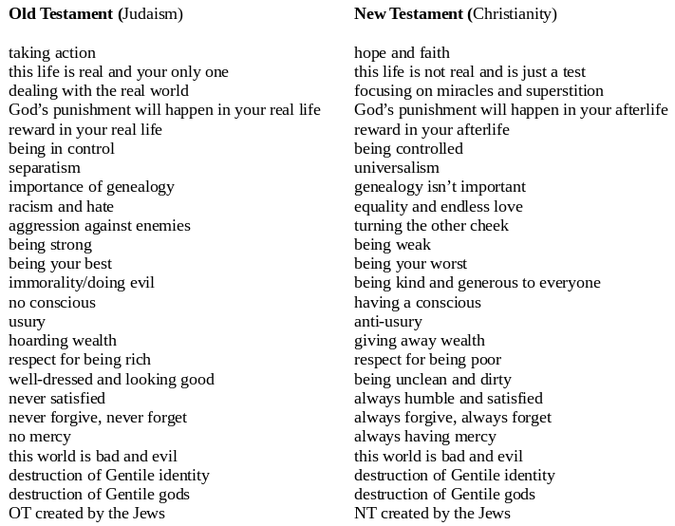Christianity is an authoritarian religion and was designed to control large groups of people. Christianity (New Testament) is a religion of subservience. While Christianity is a religion of subservience, Judaism (Old Testament), it’s sister religion, is a religion of authority. This trick is what few people see. Christianity has done everything to destroy the tribalism of it’s adherents while making them enslaved to the one tribe that has steadily become more powerful with the passage of time. It is the Jewish tribe. They are the ones that have created Christianity (and a host of other Abrahamic religions) that have turn their adherents into slaves. Christianity has destroyed the ancestral gods of the European people (and other peoples) and replaced them with a foreign Middle-Eastern deity that shares nothing in common with them. Jewish control over their non-Jewish subjects has become a realization in large part because the religions they have created was designed from the very beginning to enslave it’s Gentile adherents.

Jews for all of history have always seen man (Gentiles) as hateful, violent, and barbaric. For example, Ashley Montagu (Israel Ehrenberg), a social “scientist”, who worked closely with Franz Boas, who was considered the father of modern anthropology, once remarked, “if you are brought up a Jew, you know that all non-Jews are anti-Semitic… I think it is a good working hypothesis.” Similarly the attitude of the bible’s Jewish authors towards Gentiles is also reflected in their writings:
For they mouth empty, boastful words and, by appealing to the lustful desires of sinful human nature, they entice people who are just escaping from those who live in error. – 2 Peter 2:18
The entire attitude of the bible is that man is bad and evil. Man was bad for just being alive and was sinful since birth. In the Hebrew Bible (OT), Jews are considered the chosen people by Yahweh. And because they are the chosen people, it is their duty to lead all of humanity towards an “ideal” society. Jews can be redeemed for their sins by destroying all other gods on this planet and eradicating the identity of the non-Jews. Yahweh’s reward for this is power and wealth. And that reward happens in THIS life. By contrast, in the goyim bible (i.e. the NT), man’s redemption comes from begging for forgiveness for sins via prayer to a superhuman, Jesus Christ. The reward for this is eternal life in a paradise called heaven. There is no effort required of it’s adherents other than mere belief. So for the Jews, their reward is real and requires total effort on their part. For the Gentiles, their reward is imaginary and require them to do nothing.
In Christianity, unlike Judaism, emphasis is placed on the afterlife. Mortality, which is actually a natural part of life, is seen as bad and something to be avoided. Death is considered the ultimate punishment for man’s sinful nature. While mortality in the New Testament (NT) is seen as unnatural, immortality is viewed as something that is completely normal.
But if Christ is in you, then even though your body is subject to death because of sin, the Spirit gives life because of righteousness. – Roman 8:10
Jesus, the son of the Jewish god, Yahweh, is said to have been sent by him, his only son, to “liberate” man from his sins. Only through Christ can man’s sins be forgiven. Only through Christ, can man be liberated from his evil ways and this evil world. Upon liberation, man can then experience the opposite of life on earth and all the “evils” that come with it, which is eternal life in heaven with Jesus Christ and his father. How fitting is it for a character to be coming to the rescue of the Gentiles, who was said to not only be the son of a Jewish god, but also a Rabbi, the king of the Jews, and a Jew himself. Jews throughout history have always been more than eager to reform man. Jesus the Jew was no different.
The story of Jesus is nothing new. Jesus’ birth to a virgin mother, walking on water, preaching miracles to the poor, and ascending into heaven are themes that are heavily borrowed from earlier religions, folklore, and mythologies. The character of Jesus has striking similarities to Buddha, whose story preceded Christ by 500 years. Buddhism itself borrowed heavily from pagan folklore and mythologies.
Christianity’s biggest appeal has always been towards the lowest end of society – the poor, the lame, and the uneducated. These people more readily accept a belief system that vows to get them out of their current predicaments, especially if that effort is minimal and the reward is big. The message of Christianity is that all you have to do is believe and you will get whatever you want. This is why the New Testament is filled with stories of miracles to “prove” that all that is needed is hope and faith. Christianity promotes the “ideals” of lowliness, underachievement, and inaction and turns those ideals into a religion. Just because you are poor and lowly doesn’t mean you need to change is the message of Christianity. Biblical scriptures is that of pervasive pessimism. While both the OT and the NT sees the world filled with evil and hate, Judaism at least focuses on taking action. Christianity does not focus the least bit on taking action and defending it’s people. It focuses on faith and prayer to overcome. A measly belief is all there is to end that misery.
People are attracted to religions such as Christianity because it offers the promise of eternal life with nothing more than a simple belief. It is incredibly self-centered and does nothing for the people as a whole. Christianity is individualistic to the core. Judaism by contrast does not focus on the afterlife at all. When you focus on the afterlife, you value your real life less. That weakens you and your people.
Unlike earlier pagan mythologies, in which the Jesus character is borrowed heavily from, those mythologies were merely stories, not to be taken seriously. Even Buddhism does not require belief in a supernatural being. Christianity on the other hand requires a huge disconnect from reality and presents it’s stories as if it were fact.
The central theme of the New Testament is universalism. The NT, which is written solely for the Gentile audience, is inundated with messages of love, equality, and pacifism. People who are pacified are easier to control than those who aren’t. Race and class does not exist in Christianity. The only class that exist are believers and nonbelievers of Christ.
Christianity is not Anti-Semitic
Our legends and our folk-tales are the sacred lore which you croon to your infants. Our poets have filled your hymnals and your prayer-books. Our national history has become an indispensable part of the learning of your pastors and priests and scholars.
Our kings, our statesmen, our prophets, our warriors are your heroes. Our ancient little country is your Holy Land. Our national literature is your Holy Bible.
What our people thought and taught has become inextricably woven into your very speech and tradition, until no one among you can be called educated who is not familiar with our racial heritage.
Jewish artisans and Jewish fishermen are your teachers and your saints, with countless statues carved in their image and innumerable cathedrals raised to their memories. A Jewish maiden is your ideal of motherhood and womanhood.
A Jewish rebel-prophet is the central figure in your religious worship. We have pulled down your idols, cast aside your racial inheritance, and substituted for them our God and our traditions. No conquest in history can even remotely compare with this clean sweep of our conquest over you.
– Eli ravage
Christianity is NOT anti-Semitic. Christians
• Respect Jewish scriptures
• respect the Jewish god and the Jewish prophets
• treat Jews and Gentiles as the same people
The lie that Christianity is anti-Semitic has been propagated over and over by the media and disinformation websites. Probably the most famous passage in the bible that anti-Semites love to quote is John 8:44, “You (Jews) belong to your father, the devil.” What that passage (and all other passages in the NT that criticizes Jews) means is this. The reason why the Jews are considered cursed is because they chose not to accept Jesus Christ. Only through the acceptance of Christ can they be “saved.” Christian scriptures tells us otherwise that there are no differences between a Jew and a Gentile.
For there is no difference between Jew and Gentile—the same Lord is Lord of all and richly blesses all who call on him.
– Romans 10:12
As mentioned previously, Jesus was a Jew, a Rabbi, and the son of the Jewish god Yahweh. And the early disciples to Jesus were Jews. How is it that Christianity is antisemitic? Also any reader of the NT will notice the sheer amount of times the word “Gentile” appear. That word is used to to designate a non-Jew. Why does that word even exist? Is there a word for a non-French, a non-Sicilian, a non-Catalan, a non-black, or a non-Chinese? The only group of people other than the Jews, that I am aware of, that has a designation for those outside of their group are the Gypsies. Finally, hundreds of passages (carefully cherry-picked) from the OT are inserted into NT scriptures, along with their book, chapter, and verse identifiers. The writers did this to make Judaism look like a good, moral, and wholesome religion to their Christian audience. Actually, nothing is further from the truth.

